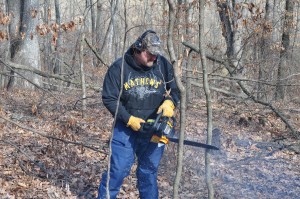Rules for habitat planning
Rules for habitat planning
I NEVER have hard and fast rules, when it comes to any habitat improvement/deer management topic. There are many things I tend to do a lot more than others, but I think it’s incredibly limiting and ultimately harmful to your goals to be rigid.

So, I don’t have any rules like always use property line access. Heck, I’ve had more than a few properties &/or client properties where property line access would have been way more harmful than going right down the center. Many properties naturally lay out so that a lot of bedding occurs along the borders. Maybe it’s a series of ridge points. In another case it may be overgrown brush/saplings/tall weeds/grass. It could be a swamp. Whatever. In any of those cases and so many more, it doesn’t make a lick of sense to create access along your property boundaries. Though there are many other reasons/scenarios it doesn’t make any sense to do it, in this one anyone that thinks it through realizes going through the bedding is
pants on head foolish and they’d drastically hurt their property doing so.
In those cases, I often use the “mature oak” approach, where I access up the “main trunk” as much as practically possible and “branch” out from there to stands…taking that approach, I’ve sacrificed the “main trunk,” but that’s often a heck of a lot better than having 15 different main access routes going all over the property. In other cases I may have 2 “mature oak” approaches. In yet others, the best route may be having 15 different main accesses. Heck, I’m sure there is a set of bizarre circumstances out there somewhere that going through bedding is even the best route.
I know that’s not what you are getting at, but I wanted to use that example to show that even something that basic can be incredibly harmful if you mistakenly believe you HAVE to cling to some silly “habitat management/design rule.” with so many diverse situations out there, clinging to rules and trying to force plans into cookie cutter designs is just plain hamstringing the manager for no good reason.
The same applies to edge access and dead zones. I’m a big believer that dead zones are a too often underutilized and drastically undervalued tool in your habitat tool box. Take Phil’s situation (6 acres, I think) or his friend that just bought 21 acres, though. Let’s say they both leave a 100 yard dead zone buffer around their properties. What do they have left to play with? Phil would have nothing. Phil’s friend could only hunt the very center of the property, somewhere around a 60’x60′ area, if my approximation is close to correct (I could seriously be off, as I just ran the numbers in my head). Obviously, that doesn’t make sense (I know you agree).
So, build a wall to screen you. Again, sounds awesome, but you better be raking it nearly daily during the fall if you think you’re going to slip past a deer under 50 yards away on a calm day, even when they can’t see or smell you…Or you’re a lot quieter than I am (which many of you may be).
There just isn’t a perfect answer for everyone. Heck, the perfect answer most often changes from area to area on a single property, based on all sorts of factors (not trying to be “cute,” just honest).
Along that south road, I PROBABLY wouldn’t create any bedding closer than 100 yards, but I can’t even guarantee that. there are more than a few situations where I actually have. That said, most often it has really been trying to screen existing bedding so that the deer couldn’t see what’s happening on the road (or access trail), but still.
In your case, the best thing MAY BE to create a blockade/screen right along your side the road. In fact, that was one of first thing I thought of when you said you had a road there, sloppy hunting neighbors and not much deer traffic coming up from the south. Doing so MAY kill 2 birds with one stone: allow you to use more of your habitat/have less dead zone, while reducing the odds further of you feeding deer to your neighbors.
Take that with a huge grain of salt, though. No way I’ve got the data to say that’s your best move.
Now, for someone with 200 acres, being able to use more of their ground may not be as important as it may be to someone with 58. On small properties, it’s often a very important consideration, particularly when one is striving to section and stack as many bucks in as they can.
If it’s a transition property (used just for travel), one may want the entire property, outside of 1 or 2 travel corridors, to be dead zones.
If it’s a destination property (used for feeding and/or checking does, but bedding elsewhere), you MAY want to use darn near every square inch, setting up right on the edge on a main access/departure route or two.
Finally, if you have the protective cover, enough sanctuary set aside for deer to feel safe and even just 20 acres of security cover, deer within winding your neighbors isn’t the absolute end of the world. So long as you make them feel safe and they have thick cover, smelling the neighbors on one side isn’t likely to cause the deer to go blowing out the other side of the property on a death run. Sometimes, they’ll actually eventually train them that human odors in that micro area is harmless. Most often, they just go a bit deeper into your property until they feel the threat is gone and return.
The way you describe your neighbors to the south, cherish them. They don’t realize it, but they are your best friends/allies. You treat your property right and all their running around and sloppy hunting will keep driving deer to take up residency on your property all season long. So long as they follow the laws, bad hunting neighbors are good property managers best friends.
P.S. if the gentleman I was talking to about this topic via PMs a couple months ago wants to chime in, he had what I think may be a productive tool for providing a little extra browse along property lines, while keeping deer travels off. It was his idea, though. I think he just added another tool to for me to pull out of the box sometime in the future, but he deserves to be the one to post about it, as it was 100% his idea. When read this and even question if it was you, it was.

